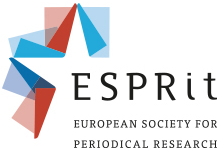ESPRit online seminar with Charlotte Lauder and Júlia Fazekas
In the Spring of 2021, ESPRit organises a series of online seminars in collaboration with ETMIET/KENI, Panteion University, Athens: Crossover influences and local identities of the popular illustrated periodicals of the 19th and twentieth centuries
The second session of the series was held on 16 April from 3-4PM CET.
Chair: Sophie Oliver (Liverpool University)
Speakers:
1. Júlia Fazekas (ELTE University, Budapest), “Popularity of Hungarian and European fashion magazines in the 1840s”
The Hungarian fashion magazines gained notable popularity in the 1840s. They were modelled after other European magazines and previous Hungarian periodicals. These magazines aimed to gain a wide readership and wanted to shape the literary sphere, publish influential works, and facilitate Hungarian education and reading through them. They mainly focused on literature, and during this period they were the most significant literary source. They contained a mixture of texts, not just literary works – they were concerned with entertainment, gossip, local and foreign news (even political content), and fashion. I believe that this thematical variety and the relation between different elements is particularly interesting in this research. In my presentation I want to look at how these fashion magazines gained popularity in Hungary and Europe. My main question is how this type of periodical can be examined from the perspective of popularity, and how their position could vary in different countries.
Watch the recording of this lecture here:
2. Charlotte Lauder (AHRC-funded PhD student, University of Strathclyde and National Library of Scotland), “Pithy people: the People’s Friend, a national magazine for Scotland”
The People’s Friend was established in 1869 in Dundee, Scotland, as a magazine for Scottish people, and is still published from that city today. A weekly illustrated penny magazine, the People’s Friend set out in 1869 to ‘encourage the literary talent which we know exists among the people’ by publishing ‘Scotch stories, poetry, and other articles, written by Scotchmen’. By 1905, the People’s Friend had created popular magazine culture in Scotland and came to define Scottish literature for the masses. How did it do this? How did a provincial literary magazine managed to sell an average of 212,600 copies per week by 1890? This presentation explores how the People’s Friend became Scotland’s most popular penny weekly magazine. It assesses the landscape of popular literature in late-nineteenth and early-twentieth century Scotland and the importance of magazine culture within it.
Watch the recording of this lecture here:
